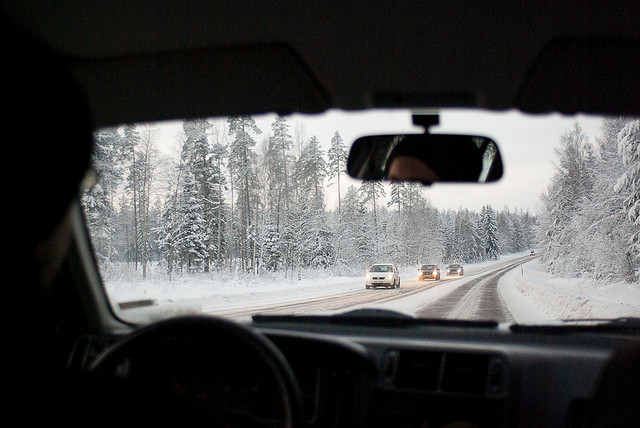Safety Tips for Winter Driving

Winter weather, regardless of its form – snow, sleet, freezing rain, ice or the catchall “wintry mix” – presents many challenges for drivers and cars alike. A simple trip to the local grocery store in bad weather can turn into a treacherous, harrowing experience for even the most skilled drivers. So how can you best prepare yourself and your car for whatever conditions Old Man Winter throws at you?
A Little Preparation Goes a Long Way
While you can’t control the weather, you can take some precautions to make winter driving safer.
Maintain Your Vehicle
Winter is not only tough on drivers, it’s tough on cars. For safety, make sure your vehicle is in tip-top shape.
- Check your tire tread and pressure, battery strength, antifreeze level and condition of your windshield wipers before you travel.
- Make sure you have plenty of windshield washer fluid to ensure visibility, and try to keep your gas tank at least half full. Gas adds weight to your car that can aid with traction, and if you are stranded, you will need to keep the car running to power the heater.
- Clear snow and ice from all windows and lights, even the hood and roof of the car. Visibility is critical in adverse road conditions, and flying snow and ice from your car can limit visibility for other drivers.
Equip Your Vehicle for Safety
Before you venture out in winter, be sure to bring the following items along – they can literally be lifesavers.
- Flashlight with extra batteries
- Snow shovel
- Jumper cables
- Bag of sand, salt, or kitty litter
- Extra windshield washer fluid
- Snow brush/scraper
- Warning flares or reflective triangles and a brightly colored cloth that can be suspended from the car window, door handle, or antenna to signal distress
- Cell phone and charger
- Warm boots, mittens or gloves, and a winter hat
- Blanket
For longer trips, it’s a good idea to have food and water, as well as medications, on board.
Adjust Your Driving for Dangerous Weather Conditions
The best strategy when the weather turns bad is to stay home if you don’t absolutely have to go out. But if you must brave the weather, you’ll need to change your usual driving patterns to navigate slippery winter roads. The following strategies should help keep you safe:
- First and foremost, buckle your seatbelt and SLOW DOWN. The posted speed limits are only appropriate for dry pavement.
- If you’re traveling in traffic, increase the distance between your car and the vehicle in front of you, and try not to make any sudden moves.
- Avoid fast starts, stops and turns. Easing into these maneuvers will improve traction and help prevent skids. If your car is skidding, steer into the skid.
- Know your brakes and brake early. If you need to stop quickly and your car is equipped with anti-lock brakes, stomp on the brake, keep your foot firmly pressing down, and focus on steering. If you don’t have anti-lock brakes, pump the brake, applying and releasing pressure repeatedly, and keep steering the car in the direction you wish to travel.
- When approaching a traffic light, ease up on your speed early, and if possible, keep your car rolling slowly forward until the light changes so you can avoid a full stop on a slippery road.
- Avoid using cruise control when driving in wintry conditions. When roads are icy, the slightest touch of the brakes can cause you to lose control of your vehicle.
- Don’t overestimate the power of an all-wheel drive (AWD) vehicle. The primary advantage of AWD in wintry conditions is to get you going and keep you moving in deep snow. It will not help you stop quicker, and it offers little help negotiating turns.
- Be aware of trouble spots on the road. Bridges are the first to freeze, and exit ramps may not have been salted or sanded as much as main roads, so exercise additional caution when traveling on them.
The Worst-Case Scenario
If you do become stranded, stay calm and follow these guidelines:
- Stay with your vehicle. It will provide temporary shelter from the elements and will make it easier for emergency personnel to locate you.
- Affix a bright colored cloth to the window, antenna, or door handle to signal distress.
- Call 911 to summon help, or dial 0 for the operator. Be ready to provide your location, your condition and that of any fellow travelers, and the problem that prompted the call.
- Avoid overexerting yourself in trying to free your car from a snow bank or drift. Otherwise, you risk adding a heart attack or other injury to your troubles.
- Run the engine periodically (for heat), but first clear the exhaust pipe of any snow, ice, or mud to avoid carbon monoxide poisoning.
Photo by Justin Kerr Sheckler / CC BY
 The Daily Dose
The Daily Dose
Comments are closed.